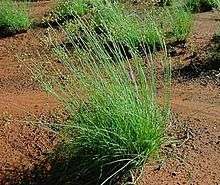Fimbristylis dichotoma
| Fimbristylis dichotoma | |
|---|---|
 | |
| Scientific classification | |
| Kingdom: | Plantae |
| (unranked): | Angiosperms |
| (unranked): | Monocots |
| (unranked): | Commelinids |
| Order: | Poales |
| Family: | Cyperaceae |
| Genus: | Fimbristylis |
| Species: | F. dichotoma |
| Binomial name | |
| Fimbristylis dichotoma (L.) Vahl | |
| Synonyms | |
|
Scirpus dichotomus L. | |
Fimbristylis dichotoma, the forked fimbry,[1] is a tufted erect, annual or perennial plant, 10–80 cm tall, with numerous long stems about 2 mm in diameter, slightly three-angled, compressed below the inflorescence, node-less, smooth. The root system is fibrous, wiry, black. Short rhizomes. Leaves numerous, forming a dense tuft at the base of the stem, being at least half as long as the stem.[2]
Distribution
Fimbristylis dichotoma is widely distributed in Asia and Africa, as well as in other parts of the tropics.[3]
Habitat
Fimbristylis dichotoma grows well on wet or even flooded soil; it is also found in uplands where the soil has good water retention. It is also found in swamps, open waste places, grassy roadsides, Imperata cylindrica grasslands and some plantation crops.[3]
References
- ↑ "Fimbristylis dichotoma". Natural Resources Conservation Service PLANTS Database. USDA. Retrieved 28 March 2016.
- ↑ "tall fringe rush (Fimbristylis dichotoma)".
- 1 2 "Fimbristylis dichotoma (tall fringe rush)".
External links
![]() Media related to Fimbristylis dichotoma at Wikimedia Commons
Media related to Fimbristylis dichotoma at Wikimedia Commons